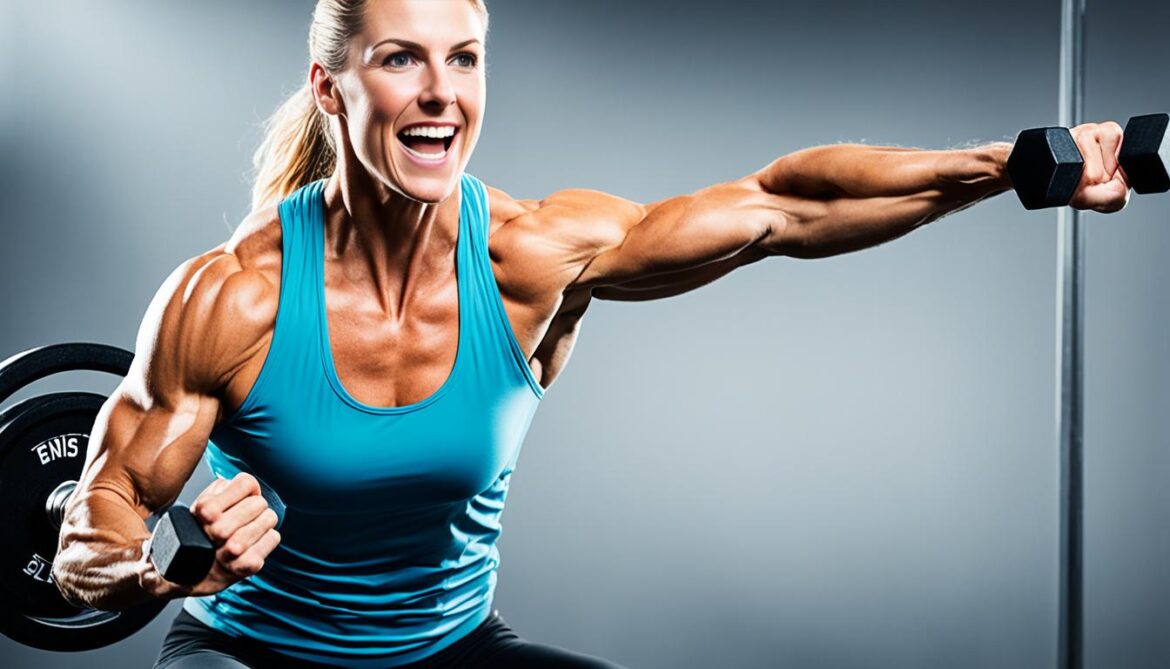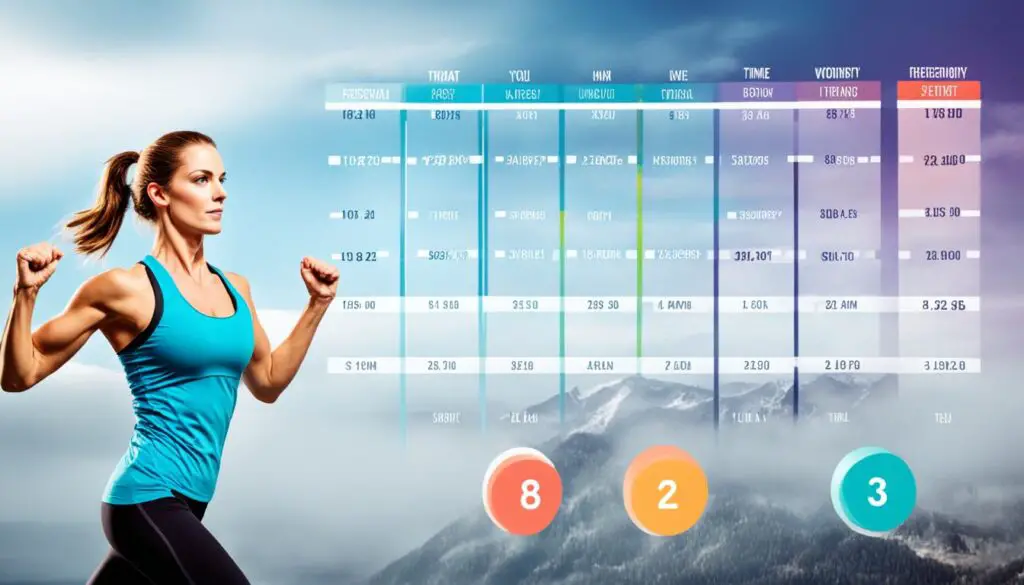Do you feel like you’re not getting far at the gym, no matter how much time you spend there? Are you looking for ways to amp up your fitness game and reach your goals faster? I’ve got what you need. This article shares secret techniques to boost your workout efficiency and see better results.
Progressive overload is a big deal in fitness. It’s about increasing the challenge in your exercises over time. This makes your body adapt and grow stronger. When you make your muscles work harder than before, you keep making gains. This approach stops you from getting stuck at a certain level.
No matter the exercise type, from weightlifting to yoga, you can apply this principle. You do this by upping the weight, increasing reps and sets, or even by working out more often. The main idea is to push yourself a bit more each time.
Yet, working harder isn’t always the answer. Finding a smart balance is key. It’s vital to pay attention to your body’s signals. Getting advice from a knowledgeable trainer can help you avoid pushing too far and getting hurt.
Ready to up your game? These insider techniques are all about getting the most from your workouts. You’ll learn to see great results without wasting time or energy.
Key Takeaways:
- Progressive overload is crucial for ongoing progress and preventing plateaus.
- Finding the right balance in workout frequency and intensity is key to optimizing results.
- Enhancing post-workout recovery through various techniques can maximize the benefits of exercise.
- Proper nutrition and adequate sleep are essential for optimal fitness efficiency.
- Incorporating periodization into your workout plans can optimize recovery and performance.
Finding the Right Balance: Frequency and Intensity of Workouts
Designing a good workout routine is all about the right balance. You need to look at both how often and how hard you exercise. People have different goals, but there are tips that work for everyone.
To get the best results, aim for 2-3 sessions of each type of training weekly. This mix should include strength, cardio, and flexibility exercises. Make sure to make weight training a top priority. It builds strength and helps with adding muscle mass.
High-Intensity Interval Training (HIIT) is a fast way to see gains. But, it’s not meant for every day. Keep your HIIT workouts to a max of three per week. This avoids too much tiredness and lets your muscles recover well.
Don’t forget about mobility work and yoga, too. They help improve how flexible you are and your joint health. Also, they build a better sense of how your body moves.
Varying your workouts keeps things fresh and helps you get better over time. Change your weight-lifting routine now and then. This keeps your progress going and challenges your body and mind.
The Importance of Balance
“I find that striking the right balance between workout frequency and intensity is crucial for sustained progress and avoiding burnout. It’s important to challenge myself but also allow for proper recovery.”
– Sarah Thompson, Fitness Enthusiast
Getting the right mix of how often and hard you work out is a personal journey. It’s vital to pay attention to how your body feels. Start slowly if you’re new. As you get stronger, you can increase how much and how hard you train to stay safe.
By finding a balanced approach to exercise, you can make the most of your fitness goals. So, discover what works best for you. This will lead you to a healthier and happier lifestyle, filled with great achievements.
Enhancing Recovery: The Importance of Post-Workout Techniques
Maximizing recovery after a workout is key for best results. Your body needs time to fix and build muscles, fill up energy, and lower swelling. The right post-workout steps can speed up coming back from exercise and make your fitness trip better.
Compression Clothing for Improved Circulation and Tissue Repair
Compression gear, like socks and sleeves, helps post-exercise. They push on muscles to better move the blood and take away waste. This boost in blood flow sends needed nutrients to muscles, fixing them and lessening pain. Using these clothes after workouts can make you heal faster and feel less tired.
Enhance Recovery with Vibration Training
Vibration plates, such as the Power Plate, shake to contract muscles and pump blood. This makes the tissue around muscles and joints looser, which helps you move better. By using vibration training after a workout, you help your muscles recover and get more flexible.
Myofascial Release Techniques for Muscle Tightness and Joint Flexibility
Foam rollers and other tools can ease tight muscles and free up joints to move better. When you press on spots with these tools, you break tension in muscle layers, helping them relax and heal. Doing this after your exercise helps you be less stiff and move freely.
Rejuvenate with Sauna and Cold Treatments
Saunas and hot tubs boost your circulation and relax you, getting rid of waste. Sauna heat makes your veins wider, carrying more food and oxygen to your muscles. Ice baths cut down on swelling and ache, helping your muscles and joints fix up. To get ready for your next workout, use sauna and ice treatments after exercising.
Replenish with Proper Post-Workout Nutrition
Eating right after working out is vital for energy and muscle healing. Mix carbs and protein in your meal or snack in the first hour after workout. This helps your body fill up energy stores and start repairing muscles. For carbs, choose fruits or whole grains, and for protein, go for chicken or tofu.
The Importance of Quality Sleep and Periodization
Sleep is crucial for making hormones and fixing tissues. Night time is when growth hormone is most active, helping with muscles. Shoot for 7 to 9 hours sleep to improve. Workouts should go from low to high power, then back. This helps your body adjust and heal.
Adding these post-exercise steps to your routine can really make a difference. You will be able to workout harder and reach your fitness goals faster. With better recovery, you can keep moving forward with your workouts, achieving more in the long run.
Conclusion
To reach fitness efficiency and get the best results, you need to use the right techniques. It’s important to keep pushing yourself a little more over time. This is called progressive overload. It helps your body keep getting better at handling exercise. You also need to balance how often and how hard you work out. Weight training is great, but don’t overdo high-intensity sessions, as they can wear you out.
Getting enough rest and recovery is just as crucial as working out. After exercise, focus on things like wearing compression clothes or doing myofascial release to help your muscles recover. Sleep is very important too. And change up your workout plan now and then to keep improving. Proper recovery will make your fitness journey more successful in the long run.
By using these tips, you can meet your fitness goals and stay healthy. Balance is key. Push yourself, but also let your body recover. Never forget how critical recovery is in reaching your highest fitness level.
FAQ
What is progressive overload and why is it important in fitness training?
Progressive overload means you make your workouts harder over time. It helps your body get stronger by forcing it to adapt. This way, you keep seeing progress and avoid getting stuck.
How can I achieve progressive overload?
To overload progressively, you can add more weight, do extra reps, or have more sets. Also, you can take less rest between exercises or work out more often.
How often and how intense should my workouts be?
Your exercise schedule and how hard you train should match your fitness goals. But, it’s generally useful to mix different types of exercise 2-3 times weekly for the best results.
Is weight training important?
Yes, weight lifting is key for getting stronger and building muscle. It’s a must-do for many fitness plans.
How often should I do High-Intensity Interval Training (HIIT)?
For HIIT, aim for up to three sessions weekly. This helps prevent too much tiredness and lets your muscles heal well.
What are some post-workout recovery techniques?
Wear compression gear and try vibration training. Foam rolling and using a sauna also help. Don’t forget cold treatments, eating right, and getting enough sleep.
How can compression clothing enhance recovery?
Compression wear boosts blood flow. It helps muscles repair faster and reduces swelling.
What is vibration training and how does it help with recovery?
Vibration training makes your blood flow better. This improves how well your tissues bounce back, aiding recovery.
What is myofascial release and how does it benefit recovery?
Myofascial release, like foam rolling, relaxes tight muscles. It makes joints more flexible, easing recovery and reducing the risk of injury.
How can saunas and hot tubs aid in post-workout recovery?
These heat options get your blood moving. They help clean out waste and bring in nutrients for repair.
What are some cold treatments that can promote recovery after a workout?
Cold therapies, from ice baths to cryo, lower swelling. They speed up healing in your body’s hard-worked areas.
How important is post-workout nutrition?
Eating right after you exercise is critical. It fuels your body back up and helps with muscle fixing.
Why is sleep essential for post-workout recovery?
Getting enough rest helps your body heal. It’s when hormones that repair and grow muscles are at their highest.
What is periodization and how does it optimize recovery?
Periodization is when you have hard and easy training times mixed together. It makes the body stronger and ready for the more intense effects of future workouts.
Source Links
- https://www.businessinsider.com/progressive-overload-fitness-meaning-and-how-to-do-it-2021-1
- https://coveteur.com/2020/01/28/kirsty-godso-workout-routine-tips-nike-master-trainer/
- https://www.acefitness.org/resources/pros/expert-articles/6422/top-strategies-for-optimal-recovery-between-workouts/



